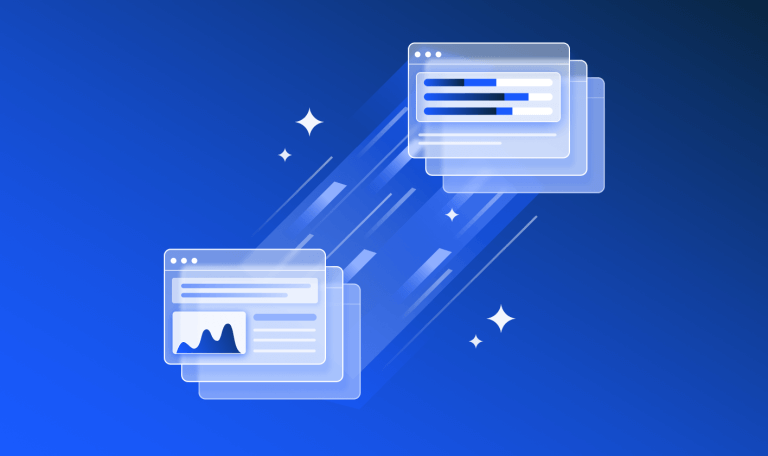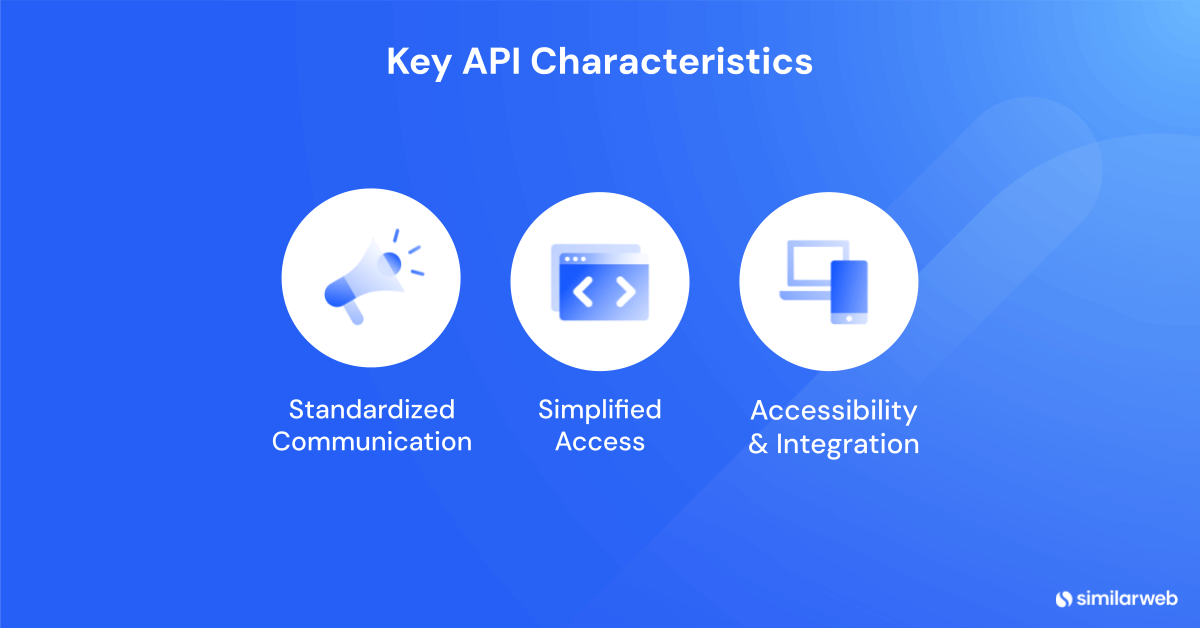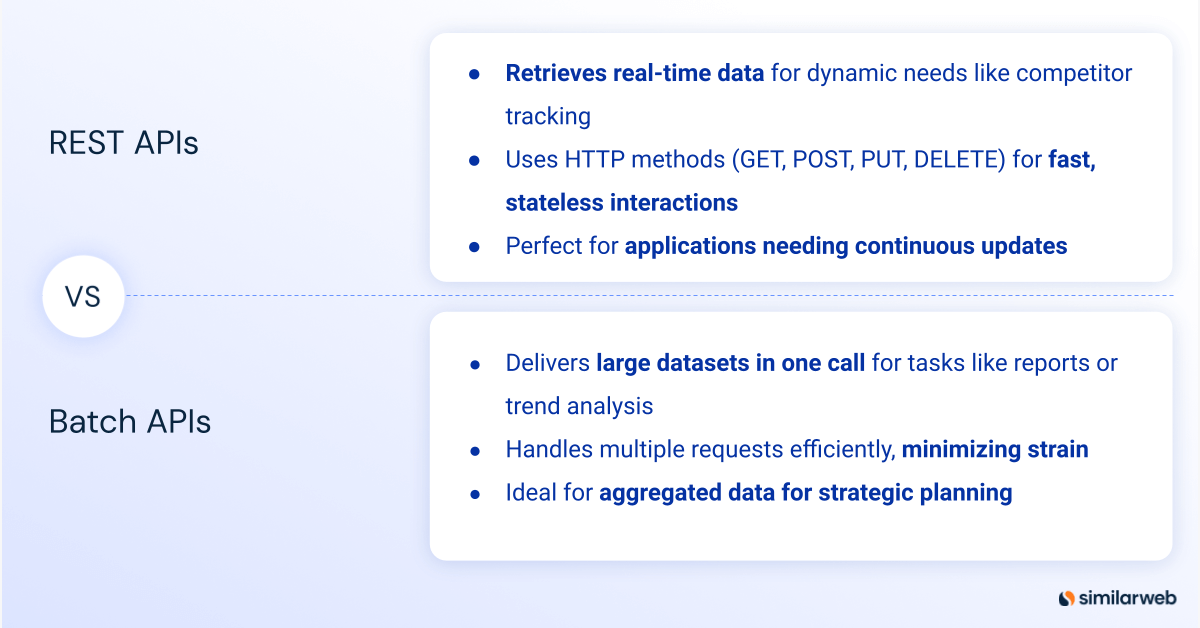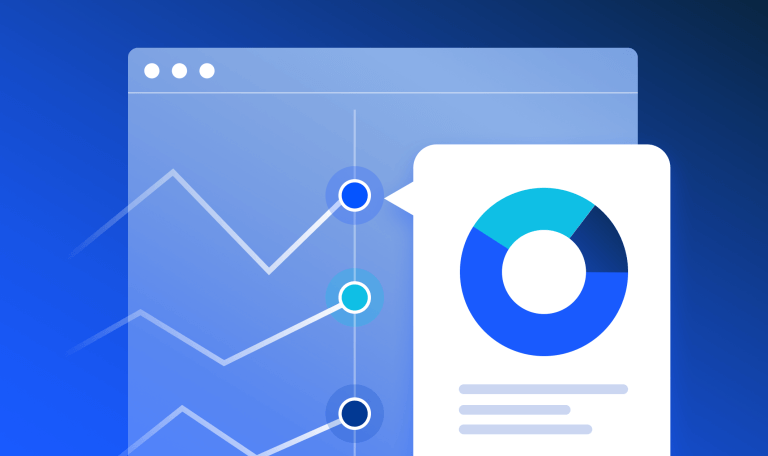What is an API? Using Data at Scale is Better for Your Business

Sherlock Holmes once said, and rightly so, “It is a capital mistake to theorize before one has data.” Without it, your power of deduction is stifled. How do you determine if your strategies are effective and successful?
In a world where data flows constantly between apps, websites, and devices, a powerful connector behind the scenes is helping businesses make smarter decisions: the API, one of many data-as-a-service (DaaS) solutions.
APIs aren’t just about transferring data — they enable companies to harness vast amounts of information from multiple sources to create insights that drive strategy. 56% of enterprise leaders agree that APIs help them build better digital data experiences and products. Whether it’s analyzing competitor website traffic, tracking customer behaviors, or integrating real-time trends, APIs provide a direct line to the data that fuels businesses.
So, what exactly is an API, and why does it matter so much in today’s big data world?
We’ve got all the answers you need right here. 👇
What is an API?
An API, or Application Programming Interface, is a structured set of rules and tools that enables two software applications to communicate with each other. APIs allow different systems to send and receive data or perform actions without needing direct access to each other’s code or database. Think of it as a way for different applications to request and deliver data or services in a structured, predictable way.
When an application wants to use an API, it sends a request—a specific set of instructions defined by the API’s structure. The receiving application processes the request, retrieves or processes the necessary information, and then sends back a response in a predefined format. This response contains the data or result the requesting application needs to continue working or displaying information.
Think of it like this: an API is like a power adapter for your devices. It connects two systems—your device and the power source—without you needing to understand the details of how electricity works. You just plug in (make a request), and the adapter delivers the energy (data or functionality) in the right format for your device. Similarly, an API connects applications, translating requests and delivering responses so everything works smoothly together.
The key attributes of an API include:
- Standardized communication or predefined protocols and data formats to ensure that data exchanges are consistent and easily understood
- Simplified access allows users to perform certain functions without needing technical know-how. You just request the data, and the API delivers
- Improved accessibility and integration let APIs enable different systems, platforms, or applications to integrate and work together
When should you use an API?
Whenever you need to integrate data or functionality from another service or system without having to recreate it from scratch, an API managed by Data-as-a-Service providers is the answer. APIs are perfect for accessing shared data in real time, automating workflows, and connecting services seamlessly.
For example, if you need live market data, real-time customer insights on an event like Black Friday, or secure payment processing, an API can provide it efficiently and securely. Whether it’s a dashboard pulling analytics from different platforms or an ecommerce site handling transactions, APIs offer a flexible, scalable way to leverage external data and capabilities.
What are the benefits of an API?
APIs bring significant advantages and help businesses integrate, automate, and innovate with ease in today’s data-driven world.
Here are some key benefits:
- Facilitate business transformation
APIs are at the heart of digital transformation, enabling businesses to modernize their operations. Whether it’s integrating legacy systems with cutting-edge tools or unlocking new revenue streams through data-driven insights, APIs help businesses stay competitive by evolving with market demands. - Expand market reach
By connecting with third-party platforms and services, APIs allow businesses to reach more customers and partners. For instance, integrating with ecommerce marketplaces or social media platforms through APIs can increase visibility and create new opportunities for growth. - Improve data accessibility
APIs make critical data easily accessible across systems and teams. They enable real-time access to insights, whether it’s for decision-making, trend analysis, or customer personalization. With APIs, businesses can break down silos and ensure the right data is available to the right people at the right time. - Enhance cost efficiency
APIs save time and resources by reusing existing functionality and data. Instead of building everything from scratch, businesses can integrate proven tools and services through APIs, reducing development costs and accelerating time-to-market.
How do APIs work?
APIs function as the middle layer between two systems, allowing them to exchange data through structured requests and responses. When an application ‘calls’ an API, it’s essentially asking for specific data or action from another application, which the API retrieves and delivers back in a standardized format. Here’s where Batch and REST APIs come into play (both offered by Similarweb) — each offers different ways of handling data requests to best suit a variety of business needs.
REST APIs: Efficient, real-time connections
REST (Representational State Transfer) APIs are widely used for their flexibility and simplicity. Operating over the web, REST APIs use HTTP methods like GET, POST, PUT, and DELETE to request and send data. They’re designed to be lightweight, stateless, and scalable, meaning they don’t retain any data or session information between requests, which makes them highly efficient for real-time data retrieval.
When a business needs up-to-the-second information—like monitoring competitor traffic or tracking market shifts—REST APIs are the go-to choice. They make it easy to call specific data when it’s needed, without bogging down the system. REST APIs are essential for applications that require continuous updates and responsive data, providing businesses with real-time insights to make timely decisions.
Batch APIs: Bulk data on demand
Batch APIs work differently—they’re built for handling large volumes of data at once. Rather than requesting individual data points as needed, Batch APIs allow you to make multiple requests in a single call, delivering comprehensive data sets in one go. This approach is ideal for businesses that need to gather and analyze data in bulk, such as creating detailed reports or aggregating data for strategic planning.
For example, a marketing team could use a Batch API to pull historical traffic data or full keyword sets, allowing them to study trends over time without overloading the system with multiple small requests. Batch APIs provide efficiency for tasks where bulk data is key, helping businesses work smarter, not harder.
Types of APIs
APIs come in different forms, each tailored to specific needs and use cases. Here are the four main types:
1. Private APIs
Private APIs are designed for internal use within a company. They enable different teams, systems, or applications to communicate securely and efficiently. For example, a private API might allow a company’s HR system to pull payroll data from an internal database. These APIs are crucial for streamlining operations and ensuring that internal tools work seamlessly together.
2. Public APIs
Public APIs, also called open APIs, are accessible to external developers and organizations. They are designed to encourage innovation by allowing third parties to integrate with a platform. For instance, a weather service might offer a public API so developers can embed weather updates into their apps. Public APIs often help businesses expand their ecosystem and market reach.
3. Partner APIs
Partner APIs are shared with specific business partners, providing controlled access to valuable data or functionality. They’re often used to foster collaboration between companies. For example, a travel booking site might use a partner API to access flight or hotel availability from multiple providers. These APIs help businesses create strategic alliances and unlock mutual benefits without exposing sensitive information to the public.
4. Composite APIs
Composite APIs allow users to combine multiple API calls into a single request, making them ideal for applications that need to gather data from various sources simultaneously. For example, a dashboard might use a composite API to pull traffic data, customer engagement metrics, and revenue figures in one call. This approach saves time and reduces the complexity of integrating multiple endpoints.
API Use Cases: Solving Business Challenges with Data
APIs are more than just technical tools—they solve real-world business challenges by providing access to actionable data when and where it’s needed. Here’s how businesses can leverage APIs to address key use cases and how Similarweb’s APIs make it happen:
1. Competitor Analysis
Staying ahead of the competition requires real-time insights into their strategies. Businesses need to track traffic trends, audience engagement, and key performance indicators across competitors.
How Similarweb helps: Similarweb’s Website Traffic API provides detailed traffic metrics like visits, bounce rates, and engagement stats, giving businesses a clear picture of competitor performance. This data fuels strategic planning, helping companies refine their marketing efforts and identify growth opportunities.
2. Market Research
Understanding market trends and customer preferences is vital for identifying new opportunities and staying relevant. Businesses need access to comprehensive datasets that reveal how users behave online.
How Similarweb helps: The Audience Demographics API uncovers detailed insights about your target audiences, such as age, gender, and location. Paired with the Website Keywords API, you can also analyze trending search terms to stay ahead of shifting market demands.
3. Performance Benchmarking
Knowing how your digital presence stacks up against industry standards is critical for evaluating success. Comparative data to measure your website and app performance effectively.
How Similarweb helps: The App Performance API delivers key metrics like downloads, active users, and session durations, enabling your business to benchmark your apps against competitors. For websites, the Marketing Channels API reveals which channels are driving traffic, helping you focus on the strategies that work.
4. Lead Enrichment
Identifying high-value leads and optimizing marketing campaigns requires a deep understanding of potential customers.
How Similarweb helps: The Lead Enrichment API provides up-to-date data on high-potential prospects with a comprehensive set of firmographic, website traffic, and engagement metrics.
5. Conversion Optimization
Understand what’s working—and what’s not—on websites and apps with bottom-of-the-funnel metrics, like conversion rate and converted visits, and identify the best-converting Marketing Channels for a given industry.
How Similarweb helps: The Conversion Analysis API offers insights into how users interact with digital platforms, tracking key events and conversion rates. This data helps businesses fine-tune their user experiences to maximize sales or other desired outcomes.
6. Channel Strategy Optimization
Knowing which channels drive the most traffic helps businesses allocate their marketing budgets effectively.
How Similarweb helps: The Marketing Channels API provides a breakdown of traffic sources—organic, paid, direct, or social—allowing businesses to identify the most effective channels for their campaigns. This data ensures marketing resources are spent where they’ll have the biggest impact.
The power of Similarweb data: turning insight into decisions
What was it that Sherlock Holmes said? That’s right: it’s a capital mistake to operate without data. So, I paraphrased. But, in today’s fast-paced digital economy, I’m not wrong. Businesses that leverage data effectively gain a critical edge.
Similarweb empowers companies to do just that by providing unparalleled access to actionable insights through its APIs. From understanding website traffic patterns to refining PPC strategies and uncovering audience demographics, Similarweb delivers the data businesses need to stay competitive and agile.
Just ask Ronald Chen at Qualtrics LLC: “I use Similarweb’s API to integrate comprehensive traffic data directly into my dashboards, which enhances real-time decision-making and helps optimize marketing strategies. This integration streamlines data analysis, allowing for quicker and more strategic responses.”
What sets Similarweb apart is the breadth and depth of its data. By offering a comprehensive view of the digital world – spanning websites, apps, and marketing channels – Similarweb helps businesses uncover opportunities, navigate challenges, and make informed decisions with confidence. Its APIs are the gateway to this intelligence, integrating seamlessly into your tools and workflows to deliver insights exactly when and where you need them.
Whether you’re a marketer fine-tuning campaigns, a product team monitoring app performance, or a strategist keeping an eye on competitor trends, Similarweb’s APIs give you the clarity and precision you need to stay ahead.
Why let critical insights slip through the cracks? Tap into the power of Similarweb’s APIs and redefine the way you drive business success.
FAQs
What is an API?
An API (Application Programming Interface) is a set of rules and protocols that allows one software application to interact with another. It defines how requests are made, how data is exchanged, and how functionality is accessed—essentially acting as a bridge between different systems.
How do APIs work?
APIs work by sending requests and receiving responses. For example, when one application wants data or services from another, it sends a request through an API. The API processes the request and returns the requested data or action in a predefined format, such as JSON or XML.
What is the primary benefit of using Similarweb’s APIs?
Similarweb’s APIs provide direct access to high-quality, actionable data about website traffic, app performance, marketing channels, and more. They enable businesses to integrate these insights into their own systems, empowering smarter, data-driven decisions and creating a competitive edge.
Are Similarweb’s APIs customizable to fit specific business needs?
Yes, Similarweb’s APIs are highly flexible and can be tailored to suit a variety of use cases. Whether you need bulk data through Batch APIs for historical analysis or real-time insights via REST APIs, Similarweb’s solutions are designed to align with your unique goals.
Wondering what Similarweb can do for you?
Here are two ways you can get started with Similarweb today!










